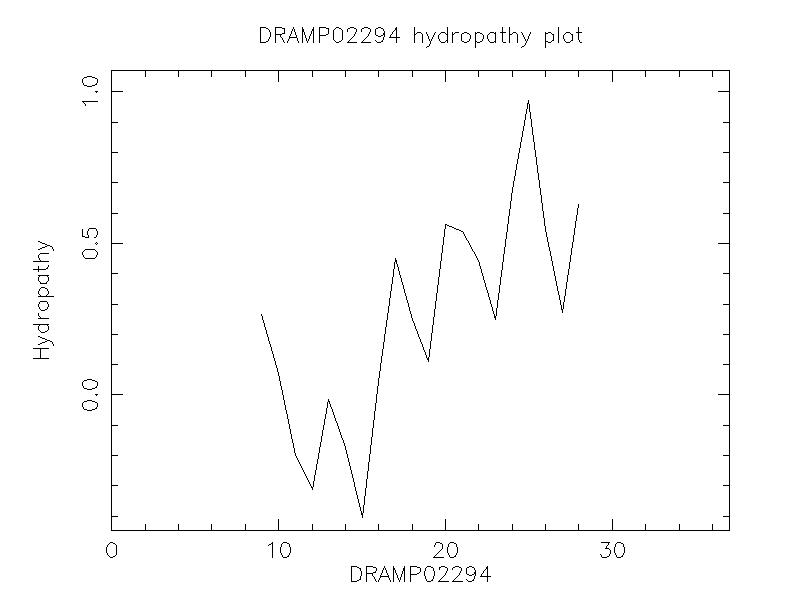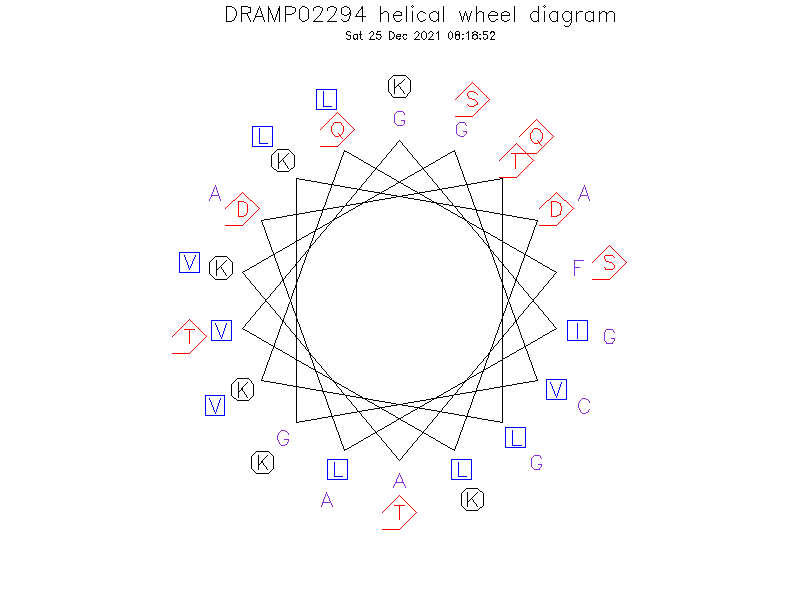General Information
-
DRAMP ID
- DRAMP02294
-
Peptide Name
- Gaegurin-4 (Gaegurin 4; GGN4; Frogs, amphibians, animals)
-
Source
- Glandirana rugosa (Japanese wrinkled frog) (Rana rugosa)
-
Family
- Belongs to the frog skin active peptide family (Brevinin subfamily)
-
Gene
- GGN4
-
Sequence
- GILDTLKQFAKGVGKDLVKGAAQGVLSTVSCKLAKTC
-
Sequence Length
- 37
-
Protein Existence
- Protein level
Activity Information
-
Biological Activity
- Antimicrobial, Antibacterial, Anti-Gram+, Anti-Gram-, Antifungal, Antiprotozoal
-
Target Organism
-
- [Ref.7999137]Gram-positive bacteria: Micrococcus luteus (MIC=2.5 µg/ml), Staphylococcus epidermidis (MIC=10 µg/ml), Bacillus subtilis (MIC=10 µg/ml);
- Gram-negative bacteria: Klebsiella pneumoniae (MIC=25 µg/ml), Shigella dysentariae (MIC=25 µg/ml), Pseudomonas putida (MIC=100 µg/ml), Pseudomonas aeruginosa (MIC=100 µg/ml), Eshchericia coli (MIC=75 µg/ml);
- Fungi: Saccharomyces cerevisiae (MIC=200 µg/ml), Candida albicans (MIC=200 µg/ml), Salmonella typhimurium (MIC=200 µg/ml), Proteus mirabilis (MIC>200 µg/ml), Serratia marcescens (MIC>200 µg/ml).
-
Hemolytic Activity
-
- [Ref.7999137] It has 0.50% hemolytic activity at 0.1 μg/ml, 0.74% hemolytic activity at 1 μg/ml, 0.78% hemolytic activity at 10 μg/ml, 1.67% hemolytic activity at 100 μg/ml against human red blood cells
-
Cytotoxicity
- No cytotoxicity information found in the reference(s) presented
-
Binding Target
- Not found
Structure Information
-
Linear/Cyclic
- Cyclic
-
N-terminal Modification
- Free
-
C-terminal Modification
- Cyclization (Cys31 and Cys37)
-
Nonterminal Modifications and Unusual Amino Acids
- Disulfide bond between Cys31 and Cys37.
-
Stereochemistry
- L
-
Structure
- Alpha helix (3 helices; 22 residues)
-
Structure Description
- In 100% H2O, Gaegurin 4 contains a nascent turn near its C-terminal Rana box. Under a more hydrophobic condition it forms two amphipathic helices, one long encompassing residues 2-23 and the other consisting of residues 25-34 (Ref.2).
-
Helical Wheel Diagram
-
PDB ID
- 2G9L resolved by NMR.
-
Predicted Structure
- There is no predicted structure for DRAMP02294.
Physicochemical Information
-
Formula
- C165H287N45O49S2
Absent Amino Acids
- EHMNPRWY
Common Amino Acids
- K
Mass
- 3749.49
PI
- 9.51
Basic Residues
- 6
Acidic Residues
- 2
Hydrophobic Residues
- 15
Net Charge
- +4
-
Boman Index
- -13.17
Hydrophobicity
- 0.33
Aliphatic Index
- 105.41
Half Life
-
- Mammalian:30 hour
- Yeast:>20 hour
- E.coli:>10 hour
Extinction Coefficient Cystines
- 125
Absorbance 280nm
- 3.47
Polar Residues
- 12
DRAMP02294

Comments Information
Function
- Has a broad spectrum of activity against both Gram-positive and Gram-negative bacteria, fungi and protozoa. Has hemolytic activity against rabbit red cells.
Tissue specificity
- Expressed by the skin glands.
PTM
- Contains one disulfide bond 31-37.
Literature Information
- ·Literature 1
-
Title
- Antimicrobial peptides from the skin of a Korean frog, Rana rugosa.
-
Pubmed ID
- 7999137
-
Reference
- Biochem Biophys Res Commun. 1994 Nov 30;205(1):948-954.
-
Author
- Park JM, Jung JE, Lee BJ.
- ·Literature 2
-
Title
- Solution structure and membrane interaction mode of an antimicrobial peptide gaegurin 4.
-
Pubmed ID
- 17141187
-
Reference
- Biochem Biophys Res Commun. 2007 Jan 19;352(3):592-597.
-
Author
- Chi SW, Kim JS, Kim DH, Lee SH, Park YH, Han KH.
- ·Literature 3
-
Title
- Structural organization and expression of the gaegurin 4 gene of Rana rugosa.
-
Pubmed ID
- 11004488
-
Reference
- Biochim Biophys Acta. 2000 Jun 21;1492(1):185-190.
-
Author
- Kwon SY, Carlson BA, Park JM, Lee BJ.

